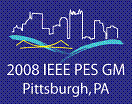
|
Technical Tutorials Meeting Registration is required plus the fee for the Tutorial |
|
Presented by Power System Planning & Implementation Committee |


|
IEEE Power & Energy Society |
|
2008 pes General meeting July 20-24, 2008 |
|
Please check back often as this page is a work in progress. |
|
A Tutorial for the Non-Power Engineering Professional Plain Talk about the Electric Power System Presented by IEEE Power & Energy Society Power System Basics—Understanding The Electric Utility Operation Inside and Out
Delivering Power to the Customer—Understanding the Planning and Operation of Today’s Distribution System; Substations and Radial Lines
The Grid—The Interconnected Electric Bulk Power System |
|
College Education Units 10 pdh = 1 CEU 4 Hour Tutorial = .4 CEU 8 Hour Tutorial = .8 CEU |
Click Schedule Below for More Tutorial Details Technical Tutorial Schedule
|
Presented by Transmission and Distribution Committee |
|
Presented by PEEC Committee |
|
Presented by Switchgear Committee |
|
Presented by Substation Committee |
|
Presented by IEEE Task Force on Dynamic Performance of Wind Generators |
|
Presented by Surge Protective Devices |
|
Presented by Electric Machines Committee |
|
Historically the development of transmission and distribution systems was largely undertaken using deterministic planning and design criteria. Though easy to use, the drawback of deterministic criteria is that they result in the expensive design of power systems that can be under-utilized except for very short periods of high electricity demand. The deterministic criteria served electric utility industry well in the past when the utilities provided bundled services to customers. In the current era of intense price and service reliability competition under the deregulated market environment, the deterministic transmission and distribution system reliability planning criteria are no longer valid. In order to be able to provide customers with the optimum service reliability at the right cost, the movement towards reliability based planning criteria and models are inevitable. Consequently, a tutorial related to this area is very timely and is expected to attract a large attendance.
This tutorial brings together instructors from academia and industry, who are able to provide a wide range of expertise on reliability techniques and applications. It summarizes the transmission and distribution systems reliability concepts and models that have been developed over the past forty years. Further, this tutorial presents the basic concepts and the recent developments in quantitative value based evaluation of transmission and distribution systems, and illustrates the practical applications of these techniques by utilities. The basic requirements of equipment outage and customer interruption cost data, and mathematical models in performing system reliability assessments are extensively covered in an easy to understand manner. The theories and models are illustrated using practical system examples. This tutorial would prove useful to anyone interested in gaining deeper understanding of transmission and distribution systems reliability and engaged in the business of electric energy systems- practicing engineers, regulators, transmission service providers, energy traders, students and academics. The materials presented in the tutorial strike a balance between basic reliability theories and their practical applications, and are presented by some of the renowned experts in the power system reliability field. |
|
The concept of distribution automation dates back to the 1970s. The main motivation was to use evolving computer and communications technology to improve operating performance of distribution systems. Initially, a few small pilot projects were implemented by a few utilities to test the concept. In the 1980s, we saw several major pilot projects. By the 1990s the technology had matured and that resulted in several large and many small projects at various utilities. It was expected that most of the utilities would embark on large-scale distribution automation. However, many utilities found it difficult to justify distribution automation based on hard cost-benefit numbers. Business uncertainties due to deregulation and restructuring of the power industry slowed implementation of distribution automation. Now, there is renewed interest in distribution automation due to emergence of new technologies, specifically new measuring devices and sensors, more powerful and refined communication equipment, highly advanced computing equipment, advanced power electronics equipment, and new control and protection ideas.
The Distribution Automation Working Group offered tutorials on Distribution Automation in 1988 and in 1998. A tutorial on Distribution Automation was offered at the General Meeting in Tampa in June 2007. About 20 people registered for the tutorial. Feedback from the participants was very positive. To build upon the success of the tutorial of 2007, we would like to offer it again in June 2008 with some modifications to make it better. |
|
The objective of this fast-paced top-down tutorial is to present 1) the role of Power Electronics in Contemporary Power Systems that Integrate Renewables /Storage, Reliable Delivery and Efficient End-Use (One Hour), and 2) to describe the operation of power electronics converters that facilitate the required interface (3 Hours).
This tutorial will be useful for all attending the PES General Meeting for the following reason: The nature of power systems has changed over the years. Many attendees like high-level managers and many power engineers educated sometime ago were never exposed to these topics that are critical in contemporary power systems. Unfortunately, the current graduates are also not taught these because the curriculum followed in most universities, with a few exceptions, has not changed to take contemporary practices into account. This concise tutorial is organized to present the understanding of power electronics – its role in contemporary power systems and understanding its operation. How much is derived by an attendee will depend on his/her background. For example, high-level managers who may have a background in another area, other than EE, will appreciate what can be done. Utility engineers working in their narrow specialty will understand alternative ways of doing things and the academics in the audience will be able to potentially reform their courses to emphasize the contemporary topics. Following is the breakdown of topics to be covered:
· Role of Power Electronics: Generation using Renewable (such as wind and photovoltaics), Storage, Reliable Delivery (HVDC transmission systems and FACTS devices such as SVC/STATCOM, TCSC etc), Efficient End-Use (requires variable-speed drives and new types of lighting), Power Quality Concerns – 1 Hour · Solid State Devices and Thyristor Circuits and Converters – 1 Hour · Operation of Thyristor Converters in HVDC and Various FACTS Devices – ˝ Hour · Understanding Switch-Mode Converters – 1 Hour · Application of Switch-Mode Converters in Various Applications – ˝ Hour |
|
Description This tutorial is designed to introduce utility engineers to the world of power electronics. The sections of the seminar will cover a Power Electronics Overview, Power Factor and Harmonics, Variable Frequency Motor Drives, and Solid-State Motor Starters. Each section will discuss the theory of operation as well as the load implications for the supplying utility. Each section will be approximately 1˝ hours with question and answer periods to follow. Attendees will receive the notes on all topics covered. Following is the break-down of the tutorial:
Power Electronics Overview This section will cover feedback control systems, rectifiers and converters, phase control, switch mode systems, SCR characteristics, a number of power electronics applications, and the principles of utility applications such as VAR compensators and HVDC converters.
Variable Frequency Motor Drives The historical development of variable frequency drives and their present use in the low and medium voltages will be discussed. The topic will cover various types of drives, their theory of operation, and their areas of application. Present day drive applications range to 35,000 hp at 13.8 kV.
Power Factor and Harmonics These two subjects come together in their effects on the supplying utility. Power electronics may inject harmonic currents and low power factors into the supply, and resonance problems can arise. The origins of harmonics, their effects, and mitigation methods will be discussed.
Solid-State Motor Starters Solid-state motor starters offer continuous control of induction motor starting currents. They can mitigate the effects of high inrush currents on the supply and reduce mechanical stresses from across the line starting. The characteristics of these modern starters and their areas of application will be discussed. |
|
Industry Standards which govern the design, testing and application of power circuit breakers have undergone significant changes throughout the years since their original publication. This natural evolution of standards follows changes in both the advancing technology of the equipment as the increasing demands imposed on them due to the complex environment which they are applied. This never-ending process makes it critical for system design engineers and planners to be aware of the current status of, and recent changes to, these standards in order to properly specify and apply this equipment.
This tutorial will begin with a historical review of the standards, describe the evolution of various rating methods used, and review the significant changes made in the current publications. This will be useful to those engineers faced with the task of specifying new circuit breakers that will be used to replace equipment that was manufactured to previous editions of the standards.
A review of the most common types of circuit breaker interrupter technologies will be conducted. Transient recovery voltage (TRV) application considerations and specific switching duties will be presented. These include terminal faults, short line faults, and out-of-phase switching. Changes to the TRV envelope specifications which are in the process of being implemented into the IEEE Standards will be reviewed. Unique characteristics of switching capacitive and inductive loads are also presented.
A review of the methods used to test high power circuit breakers is part of this tutorial. Considerations that are necessary for proper design and selection of equipment destined for installations in seismic areas are also covered.
It is recognized that time constraints limit the scope of this tutorial to provide summary information on the topics presented. However, sufficient background and reference material will be identified to enable the attendees to probe further in each topic covered.
The contributions of the authors for each section are gratefully acknowledged. They are each recognized experts in the field which they have written and presented, as well as in the related fields of circuit breaker design, ratings and applications. |
|
Wind generation continues to advance at a rapid pace in terms of technology and installed capacity. In some areas of Europe and North America wind power plants already have a major impact on power system performance. This tutorial will provide detailed information on representation of wind power plants in large-scale power flow and dynamic stability studies, as well as short circuit. Wind power plant performance and controls will be covered in detail to frame the requirements and approaches for modeling and simulation. Topics will include overview of the wind industry, steady-state representation, dynamic representation, short circuit representation, and recent experience with interconnection studies. Existing or future interconnection standard such as LVRT, reactive power/power factor control, frequency response, etc, will be discussed to the extent that they affect modeling and simulation. Integration issues such as reserve requirements, integration cost are outside the scope of the tutorial. |
|
Fast control of reactive power by means of shunt-connected static devices is a proven technology. Working group I4 on Static Var Compensators of the High Voltage Power Electronics Stations Subcommittee has maintained a list of industrial and utility Static Var Compensator (SVC) installations around the world and found more than 500 of these installations still in service after 25 years of operation. SVCs are still considered today as a competitive solution to meet future needs of reactive power compensation.
Past tutorials offered on Static Var Compensators have focused mainly on power system aspects and on justifying the need for SVCs. This tutorial is focusing on equipment design and operations. A brief review of system aspects which justifies the need for fast reactive power compensation and a description of various applications is presented. It is intended to provide participants with a solid understanding of basic components and their integration in substation design, of control system and its dynamic performance and commissioning of SVCs.
This tutorial targets engineering personnel, plant and design engineers, and anyone responsible for: (1) validating the dynamic performance during the design stage and (2) ensuring reliable operations of Static Var Compensators. |
|
This one-day workshop is designed to help energy service professionals, and electricity users understand lighting protection principles from a practical applications perspective. The workshop will provide a very broad background on the subject matter as taught by some of the noted experts in the field. Attendees will learn about the various protection technologies and applications through real world case studies as well as intermediate and advanced level technical discussions. The workshop summarizes the latest IEEE Surge Protective Devices Committee developed standards, information, methodologies and techniques for evaluating, specifying and applying SPD’s. The first half of the workshop focuses on up-to-date methods of power system protection for high voltage (HV) applications. The second half focuses on SPD’s for low voltage (LV) applications. This course will help the novice understand the fundamentals, and the experienced engineer better understand the details. Attendees come mainly from system design, maintenance, and planning groups with engineering backgrounds. |


|
Lunch is not provided the tutorial attendees, but time is allotted to eat lunch in or near the hotels and convention center. |
|
IEEE PES 2008 GENERAL MEETING |
||||||||
|
|
||||||||
|
Hour |
July 20 |
July 21 |
July 22 |
July 23 |
July 24 |
|||
|
Sunday |
Monday |
Tuesday |
Wednesday |
Thursday |
||||
|
7:30 AM |
|
|
|
|
|
|||
|
8 AM |
Plenary Session |
|||||||
|
9 AM |
||||||||
|
10 AM |
||||||||
|
11 AM |
||||||||
|
12 PM |
LUNCH |
LUNCH |
Awards Luncheon |
LUNCH |
LUNCH |
|||
|
1 PM |
Understanding Power Electronics in Contemporary Power Systems |
|||||||
|
2 PM |
||||||||
|
3 PM |
||||||||
|
4 PM |
|
|||||||
|
5 PM |
Reception |
Poster Session |
|
|
||||
|
5:30 PM |
|
|||||||
|
IEEE PES 2008 GENERAL MEETING |
||||||||
|
|
||||||||
|
Hour |
July 20 |
July 21 |
July 22 |
July 23 |
July 24 |
|||
|
Sunday |
Monday |
Tuesday |
Wednesday |
Thursday |
||||
|
7:30 AM |
|
|
|
|
|
|||
|
8 AM |
Plenary Session |
|||||||
|
9 AM |
||||||||
|
10 AM |
||||||||
|
11 AM |
||||||||
|
12 PM |
LUNCH |
LUNCH |
Awards Luncheon |
LUNCH |
LUNCH |
|||
|
1 PM |
Understanding Power Electronics in Contemporary Power Systems |
|||||||
|
2 PM |
||||||||
|
3 PM |
||||||||
|
4 PM |
|
|||||||
|
5 PM |
Reception |
Poster Session |
|
|
||||
|
5:30 PM |
|
|||||||